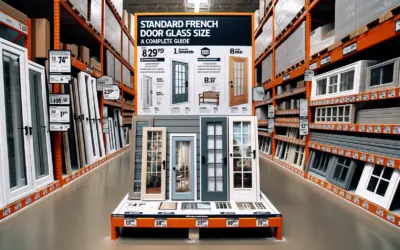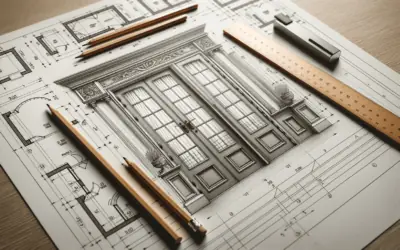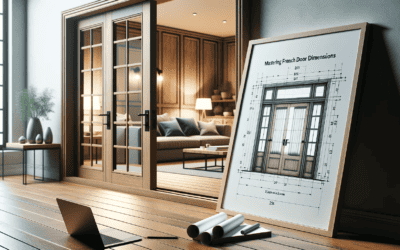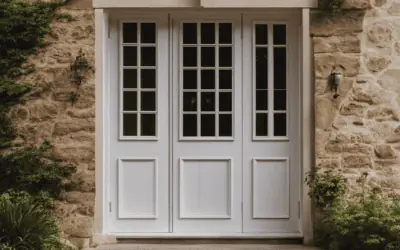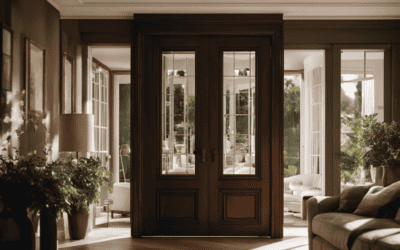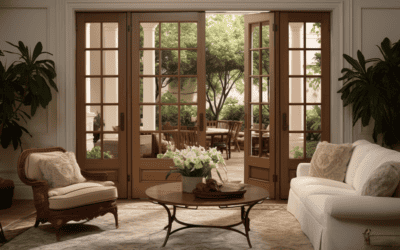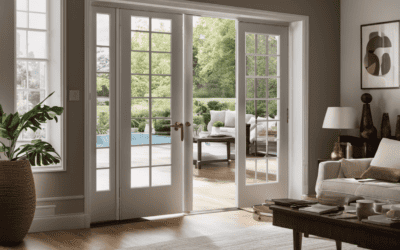 When it concerns French-style doors, it’s essential to ensure adequate space between the door frames to enable them to operate smoothly. Door installers typically aim for a gap of 3mm to 5mm in thickness, as anything exceeding 5mm will appear unsightly and could cause issues.
When it concerns French-style doors, it’s essential to ensure adequate space between the door frames to enable them to operate smoothly. Door installers typically aim for a gap of 3mm to 5mm in thickness, as anything exceeding 5mm will appear unsightly and could cause issues.
If there are uneven gaps between the door and the head jamb, or if the holes are more significant at the bottom of the two doors, shimming the hinges is an effective solution. In addition, it’s recommended to perform routine maintenance checks on all screws on each hinge as they may loosen over time, causing the doors to sag.
To summarize, French doors must have a small gap to function correctly, but they should not be too large. If uneven gaps are present, shimming the hinges is necessary, and ongoing maintenance checks are crucial. Additionally, all essential concepts to consider are door frames, door gap thickness, door hinge shimming, door maintenance, door sagging, uneven door gaps, head jamb gaps, door screws, and French-style doors.
Why is there a gap between my French doors?
Several reasons you might be experiencing a gap between your French-style doors. Here are some of the most common causes to consider.
One potential issue is loose screws. The screws holding the hinges in place can gradually come loose over time due to regular use, which can cause the doors to sag and create an unsightly gap. To fix this, you can use a screwdriver to tighten the screws in each hinge.
Another possible culprit is incorrect door installation. Regular opening and closing can cause the weather seal between the doors to bend, tear, or wear out, leading to a gap. It’s also important to check that the doors are hanging plumb and that both door frames are still square when closed. To test this, you can use a 4-foot level on the edge of the door.
It identifies which of your French doors is active and which is stationary. The functional door is the one that opens regularly and typically has a doorknob lock, while the fixed door has a floor-locking mechanism in place and doesn’t have a doorknob lock. If it’s unclear which door is which, choose the one most frequently used as the active door.
Ultimately, identifying the cause of the gap in your French-style doors is the key to determining the best action to fix it properly. Loose screws, door installation, door sealing, door alignment, floor-locking mechanism, door repairs, fixing gaps, and French-style doors are all crucial concepts to keep in mind.
What is the gap between double doors called?
The gap between the two French doors is typically known as the “middle gap”, “the gap”, or the “gap between the door frame and wall”. To ensure that your doors can open and close properly, this gap should be between 3mm and 5mm, barely more than ¼ inch.
If you’re experiencing a gap between your French doors, several solutions are available. Adjusting or replacing the door hinges is one way to ensure they are correctly aligned. Additionally, weatherstripping can seal the gap and prevent drafts from entering your home. Another option is to adhere to moulding strips or v-strips to fill the hole and create a more aesthetically pleasing appearance.
When fixing a gap between your French doors, it’s essential to remember the importance of door clearance and alignment. You can ensure that your doors are well-sealed against the elements by installing weatherproofing and insulating strips. Additionally, checking the support between the door frames and the wall is crucial to prevent any issues with opening or to close the doors.
Overall, fixing the gap between your French doors requires careful attention to detail and an understanding of the available solutions. Door gaps, door clearance, door alignment, door hinges, door seals, weatherproofing, insulating strips, door frames, and wall clearance are all important concepts to consider when working on this project.
Standard gap between door and frame
It’s important to understand that the amount of space between a door and its frame can vary depending on the type of door and its location. For example, for interior and exterior doors, different gaps may appropriately account for humidity levels and ventilation needs.
For an interior door, experts recommend leaving a gap of ⅛-inch around the sides and top of the frame, as well as a gap between the floor and bottom of at least 2 – 2.5 cm (0.8 – 1 inch). On the other hand, it is most suitable to leave only minimal clearance at the bottom edge when dealing with an exterior door to avoid drafts or water infiltration.
Besides size considerations, it should also be noted that all four door edges should have the same gap distance to guarantee efficient operation; furthermore, setting extensive clearances can potentially lead to security or energy efficiency problems.
French door gap at the top
 French doors are a great way to introduce natural light and a touch of style and beauty in any room. Over time, however, these doors may develop an undesirable gap at the top, which might end up compromising their functioning and energy efficiency. Here is what you can do to solve this issue:
French doors are a great way to introduce natural light and a touch of style and beauty in any room. Over time, however, these doors may develop an undesirable gap at the top, which might end up compromising their functioning and energy efficiency. Here is what you can do to solve this issue:
One potential corrective measure is making sure that all screws on the hinges are firmly tightened. Most of the time, this simple step can effectively solve the problem.
Should tightening the screws prove insufficient, there is still hope: you could try adjusting the hinges. This involves ‘toeing’ and ‘heeling’ the door inwards to make it conform more snugly to its frame or move the keeps or top keep towards each other.
Those confident about their DIY skills could try inserting a piece of cardboard behind the hinges to push outwards against them, thereby closing up any divergences between both leaves of the French doors.
Finally, when gentle adjustments are not enough, it might be necessary to completely repair your French door system by readjustingaligned them properly with shims if essential and replacing any worn-out door stop moulding.
Following all these steps guarantees a beautiful finish in your home while ultimately ensuring that your French doors operate optimally and without compromise.
Gap at the bottom of the French doors
Have you noticed gaps recently near the bottom of your French doors? This is caused by misaligned hinges and can be rectified through advanced hinge adjustments. Nonetheless, there are alternatives for people not comfortable with tinkering.
One popular option is to install a weather seal tape or door sweep around the base, limiting drafts and deterring animals or creeps from entering. Or, if the doors don’t close evenly, try tacking in an extra shim behind the hinge for added support.
Given that it can be challenging to pinpoint what is causing the issue, it is recommended to seek professional assistance when settling this dilemma. Depending on what’s causing the gap, tailor a practical solution that works best for you and your space!
Astragal for double doors
Are you looking to fill the gap between two doors? An astragal could be the perfect solution. An astragal is an adjoined seal designed explicitly for double-dooring stiles to stop air, sound or smoke passage through gaps. Here are some suggested options for astragals for dual entranceways based on your requirements:
The Raven RP42 and RP79: Raven offers numerous astragal seals for diverse doors, including reinforced glass and double timber doors. These seals have clip-on installation and can be affixed with the self-adhesive property. In any way desired, they grant maximum weather and acoustic protection available.
Raven RP16Si: This specific acoustic and smoke-proof astragal seal is manufactured especially for plain or recessed double entryways. It has aluminium trimming that provides a secure weatherproof rebate stop, which can be tested to enable appropriate locks and latches.
Portas T Rounded Astragal Moulding: This specially devised moulding is designated to close gaps between paired-up doors snugly to ensure wind-tight closing of its counterpart door. It should be fixed securely on the outer side of only one doorway, with its suspension rebate accommodating the corresponding entry snugly at close range.
In conclusion, your choice of the perfect astragal must focus mainly on the sort of double doors you possess in your home, the level of protection required, and the installation technique suitable enough according to your needs.
French door gap trim
Before resolving gaps with trim, it is essential to ensure that the doors are accurately aligned. Tightening the screws with a screwdriver can solve this issue. Additionally, it is paramount to identify the door direction for the proper trim installation. Standing on the side of the active door and pushing the door away can help in this regard.
Moreover, shims can even out spaces between doors or adjust elements like the head jamb and bottom hinged parts. If an even gap persists, but misalignment persists, then shims are necessary behind both hinges.
Once everything is adjusted correctly, appropriate trim installation can commence to cover any remaining gaps and enhance appearance. Moulding pieces and astragals should fit precisely, while caulk and wood filler fill any extra space between door frames or trim pieces.
If all these solutions fail, one may need to look into other measures, such as replacing damaged parts or the entirety of the French door, to achieve proper alignment of these beautiful home additions.
To summarise, ensuring all the screws are tightened along with identifying which door swings in which direction are essential prerequisites for fixing French door gaps with trim. Once these steps have been taken, installing trim pieces and applying caulk and wood filler will do the job successfully. However, if none of these work out, further repairs, including replaceable parts or a new French door, may be required to achieve desired results.
How to fix the gap between doors
Gaps between the door and frame can be incredibly annoying and can sometimes cause drafts. Fortunately, there are several fixes you can attempt to resolve this problem with ease.
One of the most straightforward solutions is to use weather strips; they’ll help create a barrier so air won’t escape through the gap. You may also need to replace or re-install the hinges, as these can loosen over time, causing cracks. Alternatively, you could get an adhesive moulding strip to fill the gaps.
Another fix that’s effective in blocking out drafts is a door sweep; it helps prevent air from escaping from both the top and bottom of your door. Here, you could also opt for replacing worn-out weather stripping or tightening up loose hinges on your doorframe’s sides.
Sometimes, your best bet would be routing a dado onto the bottom of your doorway. And if that gap is quite large, you’d need to readjust the frame by removing trim along the latch side and adding shims to add stability.
To ensure a successful resolution, it’s always best to identify what caused your gap before attempting any fixes – this will determine which solution is most suitable for getting rid of it once and for all!
Related Articles:
Charm and Elegance Unleashed: The Timeless Appeal of Timber French Doors
Timber French doors are a timeless architectural element that grace homes with elegance, natural warmth, and beauty. With their characteristic large glass panels surrounded by wide stiles and rails made of solid wood, these doors create an inviting transition between...
French Doors Buying Guide: An In-Depth Look
French doors are a popular choice for homeowners looking to enhance natural light, ventilation, and aesthetic appeal. With their characteristic large glass panes and narrow dividing frames, these elegant doors create an inviting indoor-outdoor flow. This comprehensive...
Standard French Door Glass Size: A Complete Guide
French doors are an elegant and timeless architectural feature known for their decorative glass panes that allow ample natural light into a space. But what are the standard glass sizes for these iconic doors? Understanding the typical dimensions of French door glass...
How Big Can French Doors Be in CM? A Complete Guide
French doors are a classic and elegant addition to any home. With their large glass panes and delicate dividers, they allow ample natural light into a space while providing a beautiful architectural focal point. But before installing these iconic doors, it's important...
Mastering French Door Dimensions: Your Ultimate Guide to Exterior Sizes
French doors are a classic and timeless architectural feature that can add elegance, charm and functionality to a home. As their name suggests, they originated in France but have been popular in the US and elsewhere for over a century. I'm a homeowner looking to...
What Are Active or Stationary French Doors
Welcome to our guide on active and stationary French doors! Picture this: you're standing in your home, longing for elegance and functionality. That's where French doors come in. These beauties consist of two door panels, one that swings open (the active side) and one...
How to Stop French Doors Slamming
French doors constantly slamming shut, causing frustration and potential damage? We've got you covered. With some maintenance and simple adjustments, you can prevent your doors from slamming and enjoy their beauty and functionality for years. Regular inspection and...
From Classic to Contemporary: The Impact of French Doors on Modern Architectural
Discover the impact of French doors on modern architectural design. From classic elegance to seamless indoor-outdoor flow, unlock the beauty of contemporary living.
The Architectural Impact of French Doors: A Historical Perspective
Discover the architectural influence of French doors! From Europe to America, their impact on design is unparalleled.
French Door Sizes: A Complete Guide to Standard and Custom Dimensions
As I step through the threshold of knowledge, let me guide you through the world of French door sizes. This comprehensive article explores the standard dimensions for exterior and interior French doors and the exciting possibilities of custom sizes. I'll also reveal...



